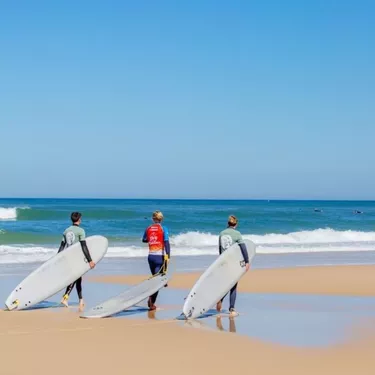The tides
In Biscarrosse, on the ocean beaches as well as on the whole Atlantic coast, a phenomenon occurs every day of the year...These are the tides ! You always wonder at what time is the high tide to be able to swim? To practice an activity? And why does the ocean recede so much? Follow us and we'll tell you all about these famous tides!
What is a tide?
Every day, the ocean rises and falls every 6 hours. This variation of the water level is due to the positions of the Moon and the Sun and their gravitational forces on the Earth. To this, we must add the rotation of the Earth on its axis, its revolution around the Sun and the rotation of the Moon around the Earth. Thus, there are generally 2 complete cycles of tides per day...2 high tides and 2 low tides, more or less important according to the coefficients.

When there is a low tide, the water does not go anywhere... It just goes down. In the Landes, the difference between high and low water, called the tidal range, is on average 5 meters.
Les grandes marées
L’amplitude de la marée est conditionnée par la position de la lune et du soleil par rapport à la terre. En période de pleine lune et de nouvelle lune, la terre, la lune et le soleil sont alignés dans le même axe. Les forces de gravitation de la lune et du soleil s’associent et les marées sont donc plus fortes. On parle de marées de "vives eaux", et les coefficients sont compris entre 70 et 120. L’attraction de la Lune étant la plus forte, on observe les plus gros coefficients lors des nouvelles lunes. Autour d’un coefficient de 90, on parle de grande marée. >> Consultez le calendrier des marées, pour savoir quand auront lieu les grandes marées à Biscarrosse.

Bayes currents
A bay is a hole of water that forms in the sand of the coast with the action of the North-South coastal current, the wind and the swell. A bay is like a natural pool formed between the coast and a sand bank.
During the rising tide, the waves pass over the sandbanks and fill the bay. Their water level is then above sea level. According to the principle of communicating vessels, the bays empty themselves with the ebb through their funnel and generate a strong current towards the open sea.
What precautions should be taken? Be careful never to swim behind a bay at high tide because you risk being swept out to sea. In any case, swim in areas supervised by lifeguards.
If you are caught in the current of a bay, stay calm. Do not try to fight the current and signal to the lifeguards or surfers.


